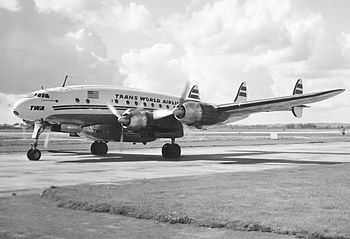Lockheed L-749 Constellation
| L-749 Constellation | |
|---|---|
 | |
| A Trans World Airlines L-749A at London's Heathrow Airport. Note the "Speedpak" under fuselage freight container. | |
| Role | Airliner |
| National origin | United States |
| Manufacturer | Lockheed |
| Designer | Clarence "Kelly" Johnson |
| First flight | March 14, 1947[1] |
| Introduction | April 18, 1947 |
| Retired | 1993 |
| Status | Retired |
| Primary users | Trans World Airlines Air France KLM South African Airways Air India Eastern Air Lines Qantas Airlinte Eireann |
| Produced | 1947 - 1951[2][3] |
| Number built | 119 |
| Developed from | L-649 Constellation |
| Variants | C-121 Constellation PO-1W/WV-1 Constellation |
The Lockheed L-749 Constellation was the first Lockheed Constellation to regularly cross the Atlantic Ocean non-stop. Although similar in appearance to the L-649 before it, the L-749 had a larger fuel capacity, strengthened landing gear, and eventually weather radar.
Design and development
In early 1947 the Lockheed Aircraft Corporation unveiled the L-749, a derivative of its L-649 Constellation with fuel tanks to increase its range by 1,000 miles. Due to the increased weight, the landing gear and tires had to be strengthened. Jet stacks were also introduced, increasing speed by 15 mph (24 km/h). These jet stacks increased the noise calling for more insulation. As with the L-649, ten different layouts of the internal cabin were possible. Airlines originally attracted to the L-649 changed their orders to the L-749. The L-749 was to become the standard version of the regular Constellation.[3][4][5]
The L-749 first flew on March 14, 1947,[1] and received certification that same month. The first L-749 was delivered to Air France on April 18, 1947. Pan American World Airways received its first L-749 in June. L-749 service began with Pan Am in June 1947 on their "Round The World" service. The L-749 also entered service with TWA and various other airlines, including KLM, Cubana de Aviación, Línea Aeropostal Venezolana, Avianca and Iberia. In March 1947, 1,200 jobs were lost at Lockheed, bringing production of the aircraft to a near stand-still. A large order from the United States Air Force for 10 L-749A aircraft designated the C-121 Constellation, saved the Constellation program from cancellation. The United States Navy followed in, ordering two L-749A aircraft designated the PO-1W Constellation (later WV-1). The first L-749A aircraft off the production lines were destined for the military.
Lockheed started producing the improved L-749A in 1949. It had a strengthened fuselage, further strengthened landing gear and a Plycor floor. This increased weight by over 4,000 pounds and increased the MTOW. A slightly redesigned engine cowling, and new Curtiss Electric propellers were also introduced. Lockheed also offered a L-749 to L-749A production kit. The first civil customer for the L-749A was South African Airways, but its largest customer was Trans World Airlines, which had 26 L-749A aircraft. The last of TWA's aircraft would not be retired until 1967. A cargo version of the L-749A based on the military C-121A was offered, but no airlines showed interest and it never left the drawing board. An L-749B turboprop version was envisaged, but this too never left the drawing board as no reliable engine was found. Production of the L-749A ended in 1951 to give way to its stretched successor, the L-1049 Super Constellation.
Variants


- L-749
- Standard production version powered by four Wright R-3350-749C18BD-1 radial engines. 60 built.
- L-749A
- Reinforced structure and an increased MTOW. 59 built.
- L-749B
- Proposed turboprop version. None built.
- L-849
- Planned version of L-749 powered by Wright R-3350 TurboCompound engines.
- L-949
- Proposed Speedfreighter combi version of L-849 with an 18 ft 4 in fuselage stretch.
Specifications (L-749)


Data from the American Museum of Aviation.[1]
General characteristics
- Crew: 4 Pilots 2-4 Flight Attendants
- Capacity: 60-81 Passengers
- Length: 97 ft 4 in (29.667 m)
- Wingspan: 123 ft (37.49 m)
- Height: 22 ft 5 in (6.8326 m)
- Wing area: 1,650 sq ft (153.29 sq m)
- Empty weight: 56,590 lbs (25,668.8 kg)
- Max. takeoff weight: 107,000 lbs (48,534.4 kg)
- Powerplant: 4 × Wright R-3350-749C18BD-1 radial engines, 2,500 hp (1,864 kW) each
- Propellers: 4 propellor
Performance
- Cruise speed: 345 mph (555.22 km/h)
- Range: 4,995 mi w/maximum fuel load
2,600 mi w/maximum payload (8,038.7 km w/maximum fuel load
4,184.3 km w/maximum payload) - Service ceiling: 24,100 ft (7.34568 km)
See also
- Related development
- Lockheed Constellation
- Lockheed L-049 Constellation
- Lockheed C-69 Constellation
- Lockheed L-649 Constellation
- Lockheed L-1049 Super Constellation
- Lockheed C-121/R7V Constellation
- Lockheed EC-121 Warning Star
- Lockheed L-1649A Starliner
- Aircraft of comparable role, configuration and era
- Boeing 377 Stratocruiser
- Bristol Britannia
- Douglas DC-4
- Douglas DC-6
- Douglas DC-7
- Ilyushin Il-18
- Lockheed L-188 Electra
- Republic XF-12 Rainbow
- Vickers Viscount
- Related lists
- List of Lockheed aircraft
- List of models of the Lockheed Constellation
- List of Lockheed Constellation operators
References
Citations
- ↑ 1.0 1.1 1.2 The American Museum of Aviation - Lockheed L-749 Technical Specifications; Retrieved 9/6/11
- ↑ US Warplanes - C-69/C-121; Retrieved 9/6/11
- ↑ 3.0 3.1 3.2 Breffort, Dominique. Lockheed Constellation: from Excalibur to Starliner Civilian and Military Variants. Histoire and Collecions, 2006, pp. 40-45.
- ↑ Lockheed Constellation Survivors - L649/L749 Constellation; Petersen, Ralph M.; Retrieved 9/6/11
- ↑ California Classic Proliners - Lockheed Constellations; Gibson, Tom; Retrieved 9/6/11
Bibliography
- Breffort, Dominique. Lockheed Constellation: from Excalibur to Starliner Civilian and Military Variants. Paris: Histoire and Collecions, 2006. Print. ISBN 2-915239-62-2
External links
| Wikimedia Commons has media related to Lockheed Constellation. |
- Lockheed Constellation Survivors - A website that explains information and whereabouts of surviving Constellations of all variants, including the L-749 Constellation.
| ||||||||||||||||||
| ||||||||||||||||||||||